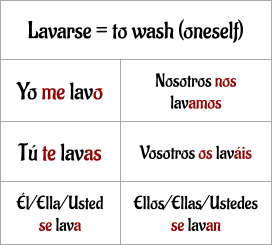Los Reflexivos
The following video was made by Shane Williams to address the concept of the Reflexive verbs. Watch the video and take notes on the concept. You can then compare your notes with the additional notes found below.
Reflexive verbs are an extension of the direct object concept. To review, a direct object is what receives the action or verb in the sentence.
Example:
Example:
|
I gave the money to my uncle.
Yo di el dinero a mi tío. |
In the above example, "the money" is what is being given, and is the direct object because it receives the action/verb directly, or it is directly affected by the action/verb.
When referring to reflexive actions, the subject and the direct objects are the same, meaning that the subject is also the direct object or receiving the action/verb.
Example:
When referring to reflexive actions, the subject and the direct objects are the same, meaning that the subject is also the direct object or receiving the action/verb.
Example:
|
Peter brushed his teeth. (Peter se cepilla los dientes.)*
|
In this example, Peter is doing the brushing and is the beneficiary of his own action. No one else is brushing his teeth and he is not brushing someone else's teeth.
*Also notice that when speaking of body parts, you avoid the use of possessive adjectives because it is implied in the use of the reflexive pronoun se.
Generally almost any action can be reflexive if the subject is the one being acted on by the verb (the direct object). Although, there are some verbs that will be "reflexive", or take on the same grammatical structure as the reflexives, in order to change their meaning (see vocabulary lists/flashcards below)
*Also notice that when speaking of body parts, you avoid the use of possessive adjectives because it is implied in the use of the reflexive pronoun se.
Generally almost any action can be reflexive if the subject is the one being acted on by the verb (the direct object). Although, there are some verbs that will be "reflexive", or take on the same grammatical structure as the reflexives, in order to change their meaning (see vocabulary lists/flashcards below)
|
Unlike the direct object pronouns, the reflexive pronouns have to agree with the subject entirely. So, if the subject is Yo, you use me with it.
Notice that the Subject Pronoun, Reflexive Pronoun and the verb are all in the same person, they all agree with the subject.
|
It is important to note that not all verbs or ideas require a reflexive pronoun, thus one of the important tasks of the student of Spanish is to learn what ideas require reflexive pronouns.
Using or conjugating the Reflexive verbs
Reflexive verbs have regular verb conjugations as all verbs, the only difference is the use and placement of the reflexive pronoun.
On a conjugated verb, the reflexive verb is always placed before the verb. With the infinitive, it is connected to the end of the verb.
Examples:
On a conjugated verb, the reflexive verb is always placed before the verb. With the infinitive, it is connected to the end of the verb.
Examples:
|
Lavarse
Yo me lavo las manos. I wash my hands. Dormirse Tú siempre te duermes en la clase. You always fall asleep in class. Levantarse Mi abuelo no quiere levantarse los domingos. My grandpa does not want to get up on Sundays. |
Modals:
When using the reflexive pronoun in conjunction with other verbs, there are two options for where to place the reflexive pronoun.
When using the reflexive pronoun in conjunction with other verbs, there are two options for where to place the reflexive pronoun.
|
1) before the first verb
ex. Ellos se necesitan lavar las manos. or 2) connected to the end of the infinitive ex. Ellos necesitan lavarse las manos. |
Present Progressive:
When using the reflexive pronoun with the present progressive form to communicate what is being done in the moment, the same rules apply to the placement of the pronoun as it is with a modal.
The reflexive pronoun is placed
1) before the first verb,
ex. Ellos se están lavando las manos.
or
2) connected to the end of the present participle
ex. Ellos están lavándose las manos.
*Note that when adding the reflexive pronoun to the end of the present participle, an accent is added to conserve the original stress point.
When using the reflexive pronoun with the present progressive form to communicate what is being done in the moment, the same rules apply to the placement of the pronoun as it is with a modal.
The reflexive pronoun is placed
1) before the first verb,
ex. Ellos se están lavando las manos.
or
2) connected to the end of the present participle
ex. Ellos están lavándose las manos.
*Note that when adding the reflexive pronoun to the end of the present participle, an accent is added to conserve the original stress point.
Thank you Sr Mara for making this video for us to enjoy. This video is to help reinforce what you have just learned from the video and the notes above.
REFLEXIVE VERBS... because the subject performs the action on itself.
|
The list of vocabulary words in the adjacent flashcards are verbs that are considered "true" reflexives because the subject performs the action on itself.
For example: poner = to put, place ponerse = to put on (oneself) acostar = to lie (something) down, put to bed acostarse = to lie (oneself) down, go to bed These particular verbs require a direct object when in use, or an object that they will act upon (She sets the table). |
|
Verbs that change meaning when in the "reflexive form"
|
These particular verbs are unique in that they change from their original meaning, to express something different. These are not necessarily considered "true" reflexives because the subject does not necessarily perform the action on itself.
There is no pattern to know which verbs take this on, but merely learned as one encounters them in reading, or finds them in the dictionary with an alternate meaning that will indicate that they have a reflexive form, and how it is used in communication. |
|


